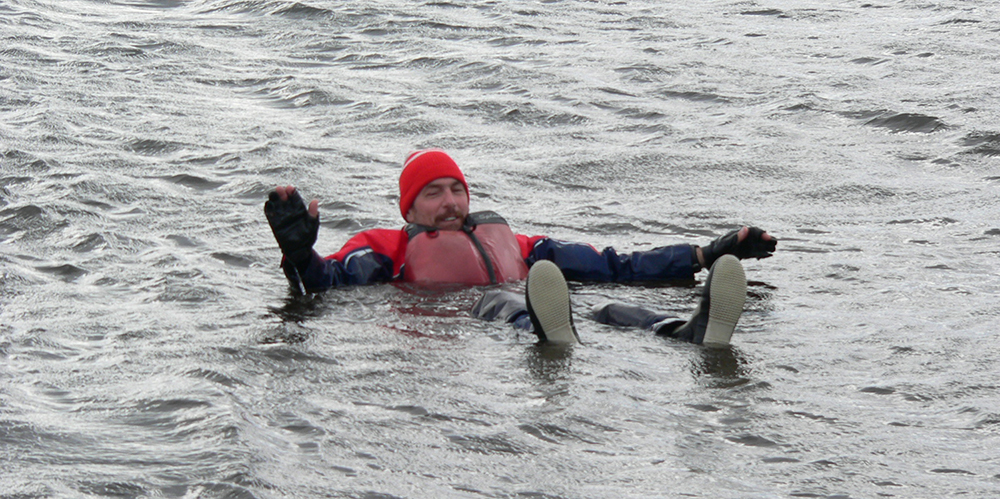
Cold Water Shock. . .
. . . is the body's involuntary response to being suddenly or unexpectedly immersed into cold water of around 15°C or lower. Any temperature below 15°C is defined as cold water and this will seriously affect your breathing and capability to move.
Over 60% of drownings are of people who have ended up in the water by accident, so they’re normally very close to the edge, but something stops them from being able to get out safely.
A sudden rise in blood pressure can be fatal for people with a pre-existing heart condition. Each year a number of people who are suspected of drowning, turn out to have had a heart attack.
REACTIONS
Cold Water Shock is a real danger in water below 15°C. If you do find yourself in the water, a lifejacket or buoyancy aid could literally save your life.
Cold Water Shock is a cause of death that many people fail to appreciate.
When the body is suddenly immersed in cold water it experiences a number of physiological responses that can rapidly incapacitate and even kill. The sudden lowering of skin temperature is one of the most profound stimuli that the body can encounter.
The biggest danger is inhaling water and drowning, even if the water is flat, calm and you know how to swim. Cold Water Shock causes an immediate loss of breathing control. You take one or more huge gasps, followed by hyperventilation – very rapid breathing that is hard or impossible for you to control.
As blood vessels contract, increases in heart rate and blood pressure may result in cardiac arrest even in people who are in good health. At the same time a 'gasp' response may result in water being inhaled into the lungs and your breathing rate may increase by as much as tenfold.
The condition causes involuntary body reactions that can be as swift as they are deadly – and the ability to swim well has no impact on these responses. It is far deadlier than Hypothermia, yet far less understood by boaters in general.
Hypothermia kills over time as heat is conducted away from the body leading to a gradual decline in body core temperature and loss of swimming ability, unconsciousness and ultimately death.
Conversely, most people who are susceptible to Cold Water Shock die in the first minute of immersion.
In the majority of cases, victims aren’t stupid or intentionally reckless, and many are strong swimmers. They simply have the misfortune of getting caught in an exceptionally lethal trap. Cold water preys on the unsuspecting and the careless, but it also waits patiently offshore for those with plenty of experience but who don’t take it seriously.
WHAT HAPPENS
Sudden cold water immersion drastically reduces your ability to hold your breath typically from a minute or so to less than 10 seconds, whilst cold water in your ears can cause vertigo and disorientation.
At a water temperature below 15°C, and if you are not wearing a life jacket, especially an automatic one, cold water shock will:
- » cause you to inhale as you go under the water, due to an involuntary gasping reflex, and drown without coming back to the surface
- » drastically reduce your ability to hold your breath underwater, typically from a minute or so to less than 10 seconds
- » induce vertigo as your ears are exposed to cold water, resulting in failure to differentiate between up and down
Cold Water Shock is a danger in water below 15°C; that’s more or less the summertime average around the coast of the UK. It is therefore important to think carefully about the clothing you wear and protection from the cold – a dry suit will provide additional protection, particularly in very cold water.
Coupled with the shock of going over the side, the condition may well contribute to a feeling of panic as you struggle to stay afloat; this will be far easier to overcome if you are wearing a correctly fitting lifejacket/ buoyancy.
WHAT TO DO
The RNLI’s advice is to float for around 60 to 90 seconds – the time it takes for the effects of the cold shock to pass and for you to regain control of your breathing. The recommended floating position is to lean back in the water and keep your airway clear while keeping calm to maintain breathing levels. You should then be in a better position to attempt to swim to safety, or call for help.
The key to surviving cold shock is being alert to the symptoms and acting quickly to protect your airway and conserve your strength. If you ever recover someone from the water, they may seem okay, but may well be susceptible to secondary drowning where any water entering the lungs can cause a condition called pulmonary oedema. This can happen within 1 to 24 hours after an incident in the water.
Symptoms to look out for are coughing, chest pain, troubled breathing, tiredness and irritability.
A close eye may need to be kept on the person after an incident in case of these delayed symptoms.









